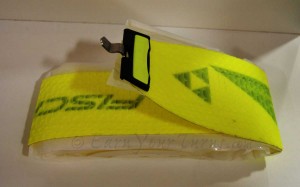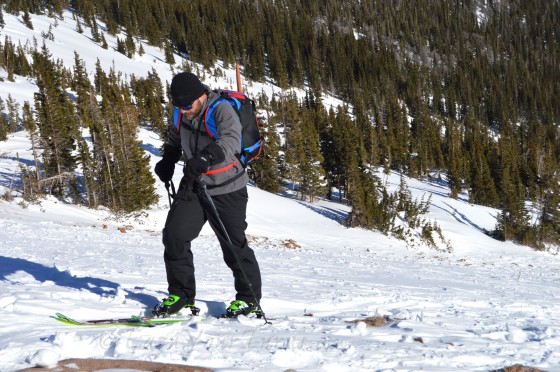
ProFoil climbing skins – Fischer’s classic XC waxless crown pattern in a full length, removable package.
ProFoil Benes
There are several benefits to these climbing skins.
- First, they won’t absorb moisture, making them less likely to ice up. As with regular climbing skins with the wrong mix of conditions (cold fresh powder on a warm spring day) it is possible for droplets of water to hide in the corners of the scales allowing ice to form but it is rare and easily removed by just doing a stomping slide forward.
- Since they don’t absorb moisture and are not a fabric based skin, they won’t stretch. Thus, when you adjust the tail clip for a pair of skis, you don’t need to set it ultra tight to allow for any stretch.
- Theoretically they are less likely to tear if you happen to ski over rocks with them, but that doesn’t mean they’re immune to damage. Scratches will inevitably affect glide, maybe grip. This is mere speculation on my part as I haven’t tested how they will stand up to such abuse.
- Finally, in moist snow conditions ProFoil’s deliver superior glide over traditional, fiber-based climbing skins. On cold dry snow, mohair glides better, but not by a lot.
Climbing Performance
The only real questions I had after a couple of quick tours last year was the limit on how well or steep they might climb in various snow conditions. In all my initial tests the skins climbed as well as trad skins, but none of those conditions were particularly challenging. The obvious potential limit was in hard icy snow were waxless patterns are known to have a limited climbing angle. In the case of waxless cross-country skis, even the wide, metal-edged variety can rarely climb in excess of 15 degrees, and only then in soft, warm snow.
For a serious test of the ProFoil’s intrinsic grip I took a chance and had my friend Alex, a rank beginner use a mixed pair of climbing skins – a ProFoil skin on one ski, a mixed mohair/nylon Colltex skin on the other – for his very first backcountry ski tour. Call me cruel if you wish, but I did carry the matching Colltex skin in case the Foil failed my inexperienced friend.
When we arrived at the Hidden Valley trailhead at 8am it had warmed to zero degrees Fahrenheit. Fingers were frozen by the time we clicked into our bindings and began heading up. Straight away Alex could tell that the ProFoils had noticeably less glide than the trad skins from Colltex on the nearly polished white path. Higher up, when the sun was high enough to add a little warmth to the air the glide improved, making the difference between skin technology less perceptible compared to the first quarter mile of low angle approach.
The line I led him up was challenging for experienced skinners, let alone a newbie. I wasn’t trying to set him up with a tough skin line, I am merely sharing that skinning conditions demanded some technique. The snow was cold and hard, not glazed, but not soft either. If you knew how to set a skin it yielded reliable grip. If you didn’t, the skin would let go. Alex had no clue about the nuances of skinning, but I shared the basic points of weighting your heels and let experience teach the finer points. I figured if the ProFoil’s were inferior for grip, a newbie with no experience would reveal that.
Aside from noticing the lack of oxygen above 11,000 feet Alex did fantastic, he was even able to skin straight up all but the last 50 vert of an 800 foot pitch at a sustained 25 degree skinning angle with no discernable difference in grip between the ProFoil and Colltex skins.
This echoed my experience of the ProFoils in cold snow too. On a cold, textured surface they hold well, but a cold loose one they aren’t so good. Warm and damp are the best conditions for the ProFoils where they grip equally with less propensity for icing up, and they absolutely glide better than a fiber plush skin in wet snow. The colder and dryer the snow, the less grip and glide.
On a different tour I found they even held well on a polished white asphalt trail, though not quite 25 degrees steep, but maybe 20. This was better than expected.
Glue
Out of the box the glue is fairly sticky. It holds well in sub-zero temps, and came off relatively easy, but not so easy I could rip the hide without taking my ski off.
You don’t store the ProFoil’s glue to glue, but rather, you fold them up with the glue sticking to the crown pattern. There are corrugations in the pattern that are designed to be folded at, so they don’t crack. It folds up fast and reliably, even in wind, and stores flat without the tendency to bunch up as fiber plushed skins do. Fischer provides a solid plastic box to store them in which might take up more volume than you want, but could also double as a storage box for other items while the ProFoil’s are underfoot.
Bottom Line
If you tend to have conditions that cause icing, generally on the wet coast where warm temps follow cold storms, ProFoils seem like a good option to have in a quiver of skins. On sub-zero days I’d stick with a fiber plush skin. For temps in the teens it would depend on conditions and a bit of technique to make them reliable. The closer temps are to the melting point, the more the ProFoils seem like a no brainer.
Fischer
ProFoil Climbing Skins
MSRP: $220
© 2016


6 comments
Skip to comment form
Interesting. Thanks for the test.
Any comments about sizing? The ProFoils I have seen for sale are for specific Fischer ski models. If you don’t have Fischer skis, do you just pick the closest size to your ski? And I’ve heard trimming is not recommended due to the angled scales at the edge.
Good Q. In fact, that lack of a generic tip loop had me stymied until I looked at it closer. The Z-clip that Fischer uses can be replaced with a “standard” wire loop by prying (carefully) the yellow cover (with the Fischer logo) up and then replacing the clip with the loop. Easy peasy.
What’s “white asphalt trail” ?
White ‘cuz it’s snow, but hard as asphalt from being heavily travelled, and thus, potentially as congested as the black asphalt variety. 😉
🙂